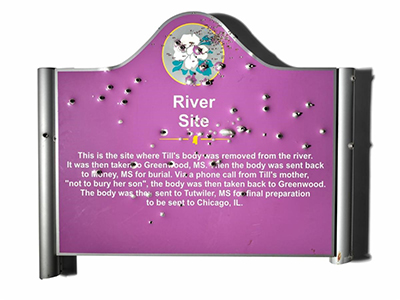By Hazel Trice Edney
(TriceEdneyWire.com) – It was a 1963 speech to teachers, in which African American author, poet and activist James Baldwin said, “American history is longer, larger, more various, more beautiful, and more terrible than anything anyone has ever said about it.”
That pointed description is what came to the mind of Dr. Anthea Hartig, the Elizabeth MacMillan director of the Smithsonian’s National Museum of American History (NMAH), when discussing the extension of the exhibit of a sign to honor Emmett Till. That sign, in recent years, was riddled with 317 bullets, demonstrating America’s ongoing struggle with racism, hate and terrorism.
On display at the NMAH since Sept. 3 – now extended until Nov. 2 – the exhibit has been a stark reminder that America continues to harbor the same evils that caused the death of the 14-year-old Chicago teenager, who was mutilated by White supremacists in Mississippi on August 28, 1955. Hartig says the exhibit is part of the vision being established by Lonnie G. Bunch III, the Smithsonian’s first African American secretary and the first African American to lead the institution of 19 museums, founded in 1836.
Bunch, also founding director of the Smithsonian’s National Museum of African American History and Culture, started his career with the Smithsonian in the late 1970s. He grew into curation alongside other young Black scholars, who largely agreed with Baldwin’s view of American history, including Baldwin’s “Talk to Teachers” in 1963.
“So, I see this powerful through line as really picking up that mantel,” Hartig says in a recent interview with the Trice Edney News Wire, especially after the creation and opening of the National Museum of African American History and Culture five years ago. “With our American History Museum’s new mission of empowering people to create a more just and compassionate future, I see kind of like the weave coming back – I hope – more wholistically into the American History Museum to represent all that the United States’ past is and all that it can teach us; and the lessons that we still need to learn, which I think are so powerfully and sadly and poignantly exemplified in the Riverside Marker.”
Starting in 2008, “the Emmett Till Memorial Commission erected nine his-torical markers to remember Till, but the signs have been stolen, riddled with bullets, or thrown in the river,” according to a news release from the museum. The display of the “defaced his-torical marker preserves the memory of Emmett Till while demonstrating the contested nature of racism’s violent legacy in America.”
The exhibit, “Reckoning with Remembrance: History, Injustice and the Murder of Emmett Till”, closes Nov. 2, but will return as part of the Museum’s offerings at a later date.
It remains in Flag Hall, a positioning which Hartig says speaks “very powerfully and viscerally to the fact that” Emmett Till and his enslaved descendants are just as important as the flag itself, which was sewn in part by an enslaved woman, Grace Wisher.
On Sept. 2, the eve of the start of the exhibit, Reverend Wheeler Parker, a civil rights activist and Till family member and Patrick Weems, executive director of the Emmett Till Interpretive Center in Money, Mississippi, teamed up with curators and officials from the Smithsonian to hold a conversation about the Emmett Till killing.
C-SPAN will be airing that panel on Saturday, October 23, at 4:15pm (EST) on American History TV on C-SPAN2. Here is the link: https://www.c-span.org/video/?514412-1/work-preserving-emmett-tills-memory. The discussion will also be made available on the Smithsonian’s YouTube channel.
The Emmett Till story has become an integral part of America’s story. During a visit to see his great uncle in Mississippi, 14-year-old Emmett Till, of Chicago, was brutally lynched Aug. 28,1955. When his mutilated body was recovered from the Tallahatchie River, his mother, Mamie Till, insisted on an open-casket funeral in Chicago. JET Magazine published a photo of the mutilated body of Till, causing it to be seen around the country. It was this photo and the Till lynching that has been credited as the impetus to the modern-day Civil Rights Movement. Only a few months later, the Montgomery bus boycott was sparked by the arrest of Rosa Parks on December 1, 1955.
Hartig credits Smithsonian curators Tsione Wolde-Michael, curator of African American Social Justice History and Nancy Bercaw, historian and curator, with successfully acquiring the marker and for telling the story that is crucial to the NMAH.
In an op-ed published in the Washington Post this week, Wolde-Michael, Bercaw and University of Kansas professor, Dave Tell, author of “Remembering Emmett Till”, doubled down on the need for the “reckoning with remembrance” that the marker exhibition illustrates.
“However, as the unrelenting defacement of the Emmett Till markers demonstrate, these advances continue to be violently contested. And whether these gains have permanence or are ultimately reversed remains to be seen,” the curators and professor wrote. “Whether in Tallahatchie County, Miss., or on the National Mall, the full work of reckoning with this history and its contestations remains. Public memory is not just created by scholars, museums and governments. We all bear responsibility for what our nation remembers and forgets. As ‘Reckoning with Remembrance’ shows us, history is an active battleground as much as it is a tool for justice.”

